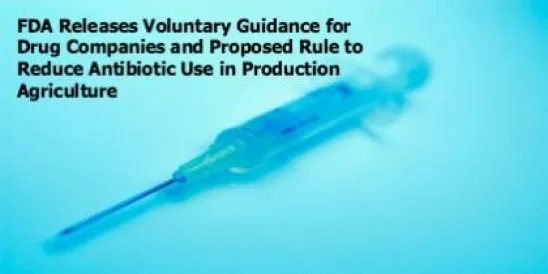In December 2013, the Food and Drug Administration (FDA) announced two coordinated efforts to phase out the use of antimicrobial drugs (antibiotics) for growth enhancement and improved feed efficiency purposes in livestock. The changes may have significant impacts on veterinarians, livestock producers, and veterinarian drug companies. This was an expected action by the FDA; two draft guidance documents that outlined this strategy were released over a year ago. The initiatives mark the next step in the FDA’s public health campaign to tamper the growth of antimicrobial resistance in humans – the process by which bacteria and other microbes gain the ability to resist the effect of drugs. The FDA’s plan was announced through two documents: 1) a guidance document for drug sponsors that proposes two voluntary actions to promote the judicious use of certain antimicrobial drugs, and 2) a proposed rule to amend the FDA’s regulation of “veterinary feed directive” (VFD) drugs.
The new guidance document for drug sponsors, Guidance for Industry # 213, contains two non-binding recommendations for drug sponsors. First, the FDA asks drug sponsors to phase out the approved use of antimicrobials for “production purposes” (i.e. for growth enhancement or improved feed efficiency, not disease prevention). Drug sponsors are asked to focus on antimicrobials that are “medically important,” (meaning the drugs are important for treating bacterial infections in humans), are available over-the-counter and are used in feed or drinking water of food-producing animals. Because it is illegal to use an FDA regulated drug not in accord with its label, drug sponsors will make it illegal to administer antimicrobials for production purposes by removing “production purposes” from the list of approved uses.
The second non-binding recommendation calls for drug sponsors to voluntarily shift medically important antimicrobial drugs to be wholly under the control of licensed veterinarians. This will require farmers to obtain prescriptions from veterinarians for some drugs that were previously available over-the-counter. The FDA states that moving control under veterinarians may slow antibiotic resistance by relying on veterinarians’ expertise to specifically treat animals with effective antibiotics and stopping the indiscriminate application of drugs to feed and water.
To date, the two largest veterinarian drug companies, Elanco and Zoetis, said they will follow the guidance. Also, both the Animal Health Institute, who represents much of the veterinarian drug industry, and the National Pork Producers Council have announced their support. The FDA has created a three year timeline to implement the voluntary measures in the guidance.
To help implement the non-binding guidance, FDA also proposed a rule on December 11, 2013 to improve the efficiency of the VFD program that will regulate the targeted antimicrobial drugs. The VFD program has been criticized by industry groups as over burdensome for years. The proposed rule uses a five pronged approach in an attempt to address the concerns of drug companies and veterinarians: it reorganizes the VFD program to make it easier to navigate; relaxes standards for veterinarian conduct and defers to state standards; allows previously over-the-counter drugs to be widely available to veterinarians at a diversity of farms; eliminates the requirement for veterinarians to specific the amount of medicated feed to be used on the VFD; and lowers record keeping requirements for involved parties.
Since the release of the guidance and proposed rule, some interest groups have maintained that the measures do not go far enough to address the FDA’s goal of reducing the growth of antibiotic resistance. Many groups cite the voluntary status of the guidance as well as the possibility that farmers may still use low-level doses of antibiotics for reasons that will still comply with approved drug uses (i.e. disease prevention). For example, the Natural Resources Defense Council (NRDC) has released a report that is critical of FDA’s action as lacking meaningful requirements and being unlikely to reduce antibiotic use. NRDC is advocating that its own legislation for reducing antibiotic use in production agriculture be advanced in Congress.
FDA has responded to this criticism by advocating for voluntary guidance as the most effective method to encourage an industry to change practices cooperatively. Additionally, the FDA has stated that if it is not satisfied with voluntary progress made at the end of the three year phase in period, it will consider using its regulatory powers to implement the changes.
Veterinarians and livestock producers should be well acquainted with the guidance documents issued by the FDA on antimicrobial drug use. If the drug sponsors follow the guidance, it will be illegal to use certain drugs to make animals grow faster or feed more efficiently within three years. The FDA maintains a list of all medically important antimicrobial drugs on its website (See Appendix A to Guidance for Industry #152). Livestock producers should consult this list to determine whether their practices may be affected by voluntary changes from the drug sponsors.






 />i
/>i
